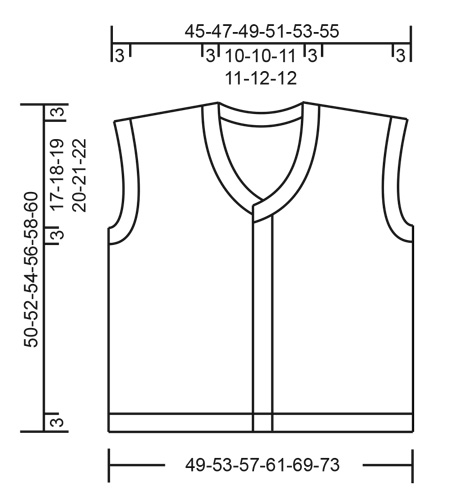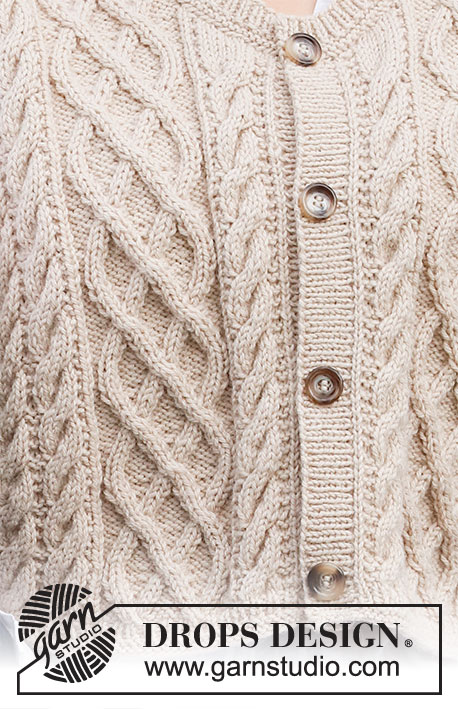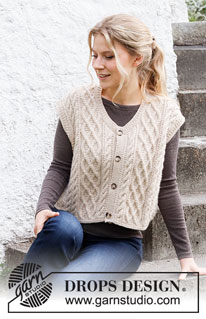Poetry Reading |
|||||||||||||||||||
 |
 |
||||||||||||||||||
Knitted vest with cables and textured pattern in DROPS Lima. Sizes S - XXXL.
DROPS 218-4 |
|||||||||||||||||||
|
------------------------------------------------------- EXPLANATIONS FOR THE PATTERN: ------------------------------------------------------- RIDGE/GARTER STITCH (worked back and forth): Knit all rows. 1 ridge in height = Knit 2 rows. INCREASE TIP (evenly spaced): To work out how to increase evenly, count the total number of stitches on the needle (e.g. 197 stitches) minus edge stitches (e.g. 2 stitches) and divide the remaining stitches by the number of increases to be made (e.g. 61) = 3.2. In this example, increase by making 1 yarn over after approx. each 3rd stitch. Do not increase over the edge stitches. On the next row work the yarn overs twisted to avoid holes. PATTERN: See diagrams A.1 to A.5. The diagrams show all the rows in the pattern from the right side. CASTING-OFF TIP: To avoid the cast-off edge being tight you can cast off with a larger size needle. If the edge is still tight, make 1 yarn over after approx. each 8th stitch at the same time as casting off; the yarn overs are cast off as normal stitches. ------------------------------------------------------- START THE PIECE HERE: ------------------------------------------------------- VEST – SHORT OVERVIEW OF THE PIECE: The piece is worked back and forth with circular needle from mid front and bottom up. Stitches are cast off for the armholes and the front and back pieces finished separately. The piece is sewn together at the shoulders. Stitches are knitted up for the bands, neck and sleeve edges. BODY: Cast on 197-213-229-245-277-293 stitches (including 1 edge stitch on each side towards mid front) with circular needle size 3 mm and Lima. Work 2 RIDGES back and forth – read description above. Knit 1 row from the right side. The next row is worked as follows from the wrong side: 1 edge stitch in garter stitch, * purl 1, knit 1 *, work from *-* until there are 2 stitches left on the row, purl 1 and finish with 1 edge stitch in garter stitch. Work a total of 4 rows of this rib, back and forth. Then purl 1 row (edge stitches knitted) AT THE SAME TIME as you increase 61 stitches evenly spaced in all sizes – read INCREASE TIP = 258-274-290-306-338-354 stitches. Change to circular needle size 4.5 mm and insert a marker thread 66-70-74-78-86-90 stitches in from each side = 126-134-142-150-166-174 stitches between the threads on the back piece. Allow the threads to follow your work onwards; they will be used when casting off for the armholes. The next row is worked as follows from the right side: 1 edge stitch in garter stitch, work A.1 (= 11 stitches), A.2 (= 24 stitches), A.3 (= 18 stitches), A.4 over the next 24-32-40-48-64-72 stitches (the marker thread sits in the middle of these stitches), work A.3 (= 18 stitches), A.2 (= 24 stitches), A.3 (= 18 stitches), A.2 (= 24 stitches), A.3 (= 18 stitches), A.4 over the next 24-32-40-48-64-72 stitches (the marker thread sits in the middle of these stitches), work A.3 (= 18 stitches), A.2 (= 24 stitches), A.5 (= 11 stitches) and finish with 1 edge stitch in garter stitch. Continue this pattern back and forth. REMEMBER THE KNITTING TENSION. When the piece measures 27-28-29-30-31-32 cm, cast off for the armholes on the next row from the right side as follows: Work the first 63-67-71-75-83-87 stitches as before (= right front piece) – place these stitches on a thread, cast off 6 stitches for the armhole (3 stitches on each side of the marker thread), work 120-128-136-144-160-168 stitches as before (= back piece) – place these stitches on a new thread, cast off 6 stitches for the armhole (3 stitches on each side of the marker thread) and work as before over the last 63-67-71-75-83-87 stitches (= left front piece). Do not cut the strand. The front and back pieces are finished separately. LEFT FRONT PIECE: = 63-67-71-75-83-87 stitches. Start from the wrong side and continue the pattern as before. AT THE SAME TIME cast off stitches for the armhole at the beginning of each row from the right side as follows: Cast off 3 stitches 0-0-0-1-1-1 time, 2 stitches 2-2-3-3-4-5 times and then 1 stitch 2-4-4-3-7-7 times. AT THE SAME TIME when the piece measures 32-33-34-35-36-37 cm, cast off stitches for the neck at the beginning of each row from the wrong side as follows: Cast off 5 stitches 1 time, 3 stitches 1 time, 2 stitches 3-3-3-3-4-4 times and then 1 stitch 10-10-11-11-10-10 times. After all the decreases for armhole and neck there are 33-35-36-38-39-41 stitches on the shoulder. Continue working until the piece measures 47-49-51-53-55-57 cm. Now work the diagonal shoulders by casting off stitches at the beginning of each row from the right side as follows: Cast off 8-9-9-10-10-10 stitches 3 times and then 9-8-9-8-9-11 stitches 1 time. All the stitches are now cast off and the piece measures approx. 50-52-54-56-58-60 cm from the highest point on the shoulder. RIGHT FRONT PIECE: Place the 63-67-71-75-83-87 stitches from the thread back onto circular needle size 4.5 mm. Start from the wrong side and continue the pattern as before. AT THE SAME TIME cast off stitches for the armhole at the beginning of each row from the wrong side as follows: Cast off 3 stitches 0-0-0-1-1-1 time, 2 stitches 2-2-3-3-4-5 times and then 1 stitch 2-4-4-3-7-7 times. AT THE SAME TIME when the piece measures 32-33-34-35-36-37 cm, cast off stitches for the neck at the beginning of each row from the right side as follows: Cast off 5 stitches 1 time, 3 stitches 1 time, 2 stitches 3-3-3-3-4-4 times and then 1 stitch 10-10-11-11-10-10 times. After all the decreases for armhole and neck there are 33-35-36-38-39-41 stitches on the shoulder. Continue working until the piece measures 47-49-51-53-55-57 cm. Now work the diagonal shoulders by casting off stitches at the beginning of each row from the wrong side as follows: Cast off 8-9-9-10-10-10 stitches 3 times and then 9-8-9-8-9-11 stitches 1 time. All the stitches are now cast off and the piece measures approx. 50-52-54-56-58-60 cm from the highest point on the shoulder. BACK PIECE: Place the 120-128-136-144-160-168 stitches from the thread back onto circular needle size 4.5 mm. Start from the wrong side and continue the pattern as before. AT THE SAME TIME cast off stitches for the armholes at the beginning of every row as follows: Cast off 3 stitches 0-0-0-1-1-1 time, 2 stitches 2-2-3-3-4-5 times and 1 stitch 2-4-4-3-7-7 times on each side = 108-112-116-120-124-128 stitches left. Continue working until the piece measures 47-49-51-53-55-57 cm. Now cast off for the diagonal shoulders on each side AT THE SAME TIME as you cast off for the neck as described below. DIAGONAL SHOULDER: Cast off for the diagonal shoulders at the beginning of every row as follows: Cast off 8-9-9-10-10-10 stitches 3 times on each side and 9-8-9-8-9-11 stitches 1 time on each side. BACK OF NECK: AT THE SAME TIME on the first row from the right side decrease 10 stitches evenly spaced over the middle 42-42-44-44-46-46 stitches. On the next row cast off the middle 24-24-26-26-28-28 stitches for the neck. Then cast off stitches at the beginning of each row from the neck as follows: Cast off 2 stitches 2 times on each side. All the stitches are now cast off and the piece measures approx. 50-52-54-56-58-60 cm from the highest point on the shoulder. ASSEMBLY: Sew the shoulder seams inside the cast-off edge. RIGHT BAND: Start on the right side, at the bottom of the right front piece, and knit up 97 to 111 stitches with circular needle size 3 mm as far as the beginning of the neck (number of stitches divisible by 2 + 1). The first row is worked as follows from the wrong side: 1 edge stitch in garter stitch, * purl 1, knit 1 *, work from *-* until there are 2 stitches left, purl 1 and 1 edge stitch in garter stitch. Continue this rib back and forth for 2½ to 3 cm. Cast off with knit over knit and purl over purl – read CASTING-OFF TIP! LEFT BAND: Start on the right side, at the top of the left front piece below the neck, and knit up 97 to 111 stitches with circular needle size 3 mm down the edge (number of stitches divisible by 2 + 1). The first row is worked as follows from the wrong side: 1 edge stitch in garter stitch, * purl 1, knit 1 *, work from *-* until there are 2 stitches left, purl 1 and 1 edge stitch in garter stitch. Continue this rib back and forth, but after approx. 1 cm work 3-3-4-4-4-4 buttonholes evenly spaced. The top buttonhole is approx. 10-10-8-8-8-8 cm from the neck and the bottom buttonhole approx. 3 cm from the bottom edge. 1 buttonhole = cast off 2 stitches and cast on 2 stitches over the cast-off stitches on the next row. When the band measures 2½ to 3 cm, cast off with knit over knit and purl over purl – remember CASTING-OFF TIP! NECK: Start from the right side and knit up 139 to 175 stitches around the neck, inside the 1 edge stitch, with circular needle size 3.5 mm (number of stitches divisible by 2 + 1). Knit 1 row from the wrong side – AT THE SAME TIME work 1 buttonhole over the others on the left band (worked in the same way as on the band; make sure it is positioned directly above the other buttonholes). Knit 1 row from the right side, knit 1 row from the wrong side and knit 1 more row from the right side. The next row is worked as follows from the wrong side: 1 edge stitch in garter stitch, * purl 1, knit 1 *, work from *-* until there are 2 stitches left, purl 1 and 1 edge stitch in garter stitch. Work a total of 4 rows of this rib. Cast off with knit over knit and purl over purl – remember CASTING-OFF TIP! SLEEVE EDGE: Start from the right side at the bottom of the armhole and knit up 110 to 138 stitches around the armhole, inside the 1 edge stitch, with short circular needle size 3 mm (number of stitches divisible by 2). Purl 1 round, knit 1 round, purl 1 round and knit 1 round. Then work 4 rounds of rib (knit 1, purl 1). Knit 1 round and purl 1 round. Cast off with knit – remember CASTING-OFF TIP! Work a similar edge around the other armhole. ASSEMBLY: Sew the buttons onto the right band. |
|||||||||||||||||||
Diagram explanations |
|||||||||||||||||||
|
|||||||||||||||||||

|
|||||||||||||||||||

|
|||||||||||||||||||
|
Have you made this or any other of our designs? Tag your pictures in social media with #dropsdesign so we can see them! Do you need help with this pattern?You'll find tutorial videos, a Comments/Questions area and more by visiting the pattern on garnstudio.com. © 1982-2024 DROPS Design A/S. We reserve all rights. This document, including all its sub-sections, has copyrights. Read more about what you can do with our patterns at the bottom of each pattern on our site. |
|||||||||||||||||||





































































Comments / Questions (35)
It would be interesting to see a back view of this project as well in the photographs, not just different versions of the front view.
30.12.2023 - 17:04Hello. Why in the A.4 grapf does'nt appears lines in white? And in the other graphs there are lines in white? I understand that in every wrong side rows i make the stitches as they appear. Please help me
09.10.2023 - 14:30DROPS Design answered:
Dear Mrs Godinez, pattern is different as the other, in A.4, you will work (seen from RS): 4 sts stocking stitch, 4 sts garter stitch for 6 rows, then 4 sts garter stitch, 4 sts stocking stitch for 6 rows. Repeat these 8 rows. Happy knitting!
09.10.2023 - 16:23Bonjour l’ échantillon donné 20 m en largeur pour 10 cm pour la taille S on compte 258 m après les côtes cela donne pour moi 129 cm pour cette veste je trouve cela grand pour une petite taille Ou est mon erreur
14.10.2022 - 18:37DROPS Design answered:
Bonjour Bernadette, l'échantillon se tricote en jersey, or, le gilet sera ensuite tricoté avec de nombreuses torsades, et, il faut plus de mailles pour faire une torsade que pour tricoter du jersey, pour la même largeur, raison pour laquelle on a besoin de davantage de mailles; si votre échantillon est juste, alors vous aurez les bonnes mesures finales comme dans le schéma en conservant cette même tension. Retrouvez ici plus d'infos sur l'échantillon. Bon tricot!
17.10.2022 - 08:54Bonjour je voudrzis fzire le modele 218_4 je voudrais le fzire en 3 morceaux je voudrais savoir pour le dos il est comment di vous avez une photos car je suis un peut perdu je fait la taille xxl merci
18.08.2022 - 10:17DROPS Design answered:
Bonjour Mme Roul, nous ne sommes malheureusement pas en mesure d'adapter chacun de nos modèles à chaque demande, mais vous pouvez vous baser sur les explications pour faire vos ajustements en fonction de la taille, adaptez le nombre de mailles (mailles lisières à ajouter) et replacer les diagrammes si besoin. Bon tricot!
18.08.2022 - 14:55Wondering if you might be able to advise me on something: I am considering knitting this pattern but want to add about 12 inches to the length. How much more yarn, would you estimate that I need?
06.05.2022 - 14:50DROPS Design answered:
Dear Mrs Baird, we are unfortunately not able to adjust every pattern to every single request, but please contact your DROPS store - they will be able to help you, even per mail or telephone. Happy knitting!
06.05.2022 - 16:05Hello, Could you please confirm if I am reading the diagrams correctly? Thank you very much for your kind help! A 1 - Row 2 (wrong side) P1, K2, P6, K1, P1 A 4 - Row 2 (wrong side) P4, K4
21.01.2022 - 16:41DROPS Design answered:
Hi Janet, read the diagrams from left to right on the wrong side. A.1 row 2: P1, K1, P6, K2, P1. A.4 row 2: K4, P4. Happy knitting!
21.01.2022 - 17:20Hello, I am stuck on the increase stitches on the body part. If i were to increase a stitch after the 3rd stitch (excluding the edge stitches), there will be total of 65 stitches increased instead of 61 stitches. Should I stop the increase after 61 stitches have been done? Thank you in advance for your kind help!
14.01.2022 - 16:57DROPS Design answered:
Dear Janet, you increase after each 3rd stitch until you have worked 61 stitches. Happy knitting!
17.01.2022 - 00:53Hi, I cannot go further back piece. I am not really sure in which order to decrease and cast off stitches in parts "diagonal shoulder" and "back of neck". Can you please explain it in more details or maybe order? I don't understand how to decrease evenly within middle sts and follow the pattern at the same time and how to continue decreasing stitches in diagonal shoulders if we casted off middle sts for neck.. finish them separately? Pls help, i really love this vest!
29.05.2021 - 13:30DROPS Design answered:
Dear Alexsandra,at the middle of the back, you simply decrease the amount of stitches,, and the next row cast off, so keeping in pattern needs only extend to keep the knit and purl stitches in order. And yes, the two shoulders needs to be finished separately. Happy Knitting!
29.05.2021 - 14:12Hej, Jag har stickat denna, men skulle vilja ha ärmar på. Kanin rekommenderar ett mönster så jag har rätt form mot skulderna? Jag kan nog anpassa mönstret själv, men hur får jag ett ärm som passar? Lotte
10.03.2021 - 13:50DROPS Design answered:
Hej Lotte. Du kan se på våra andra tröjor/ koftor i garngrupp B för att se om du hittar någon som du kan använda. Kanske att tex nr 216-38 kan fungera. Mvh DROPS Design
11.03.2021 - 06:42Are the wrong side rows shown on the diagram...or is the diagram all right side rows with doing purl in every other row...hope this makes sense
10.02.2021 - 20:23DROPS Design answered:
Dear Ag Urquhart , the diagrams show every row of the pattern. Every second row is knitted "as it seen" or "covered", that means from teh wrong side the stitches of the cables are purled, the other stitches are knitted. Happy Knitting!
11.02.2021 - 00:37